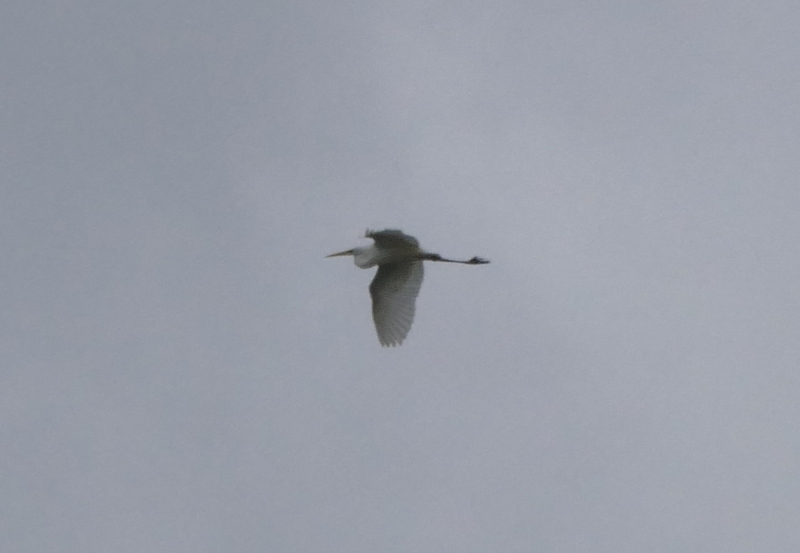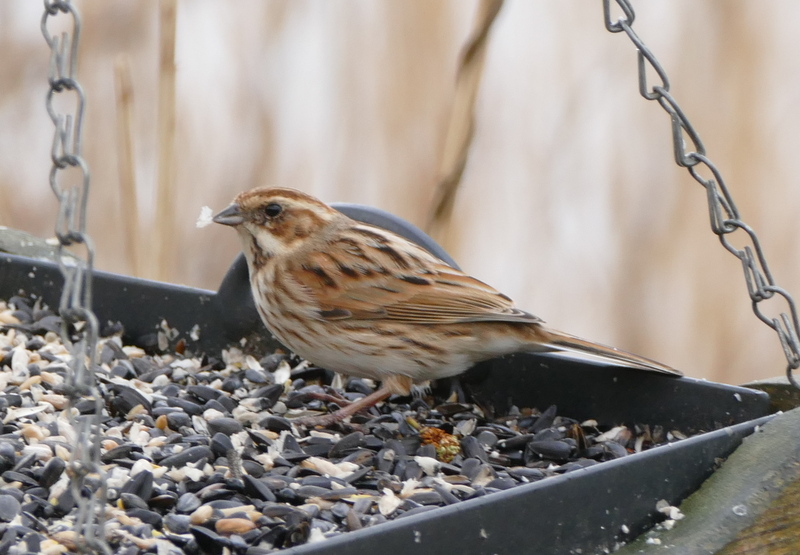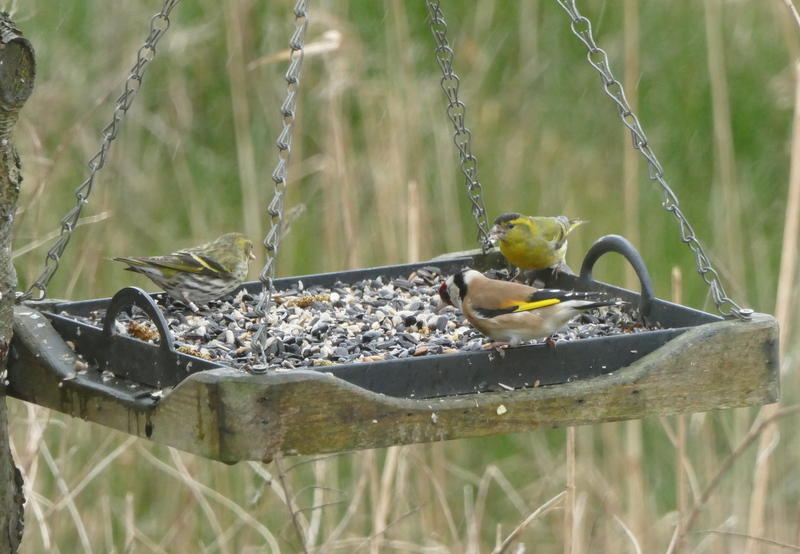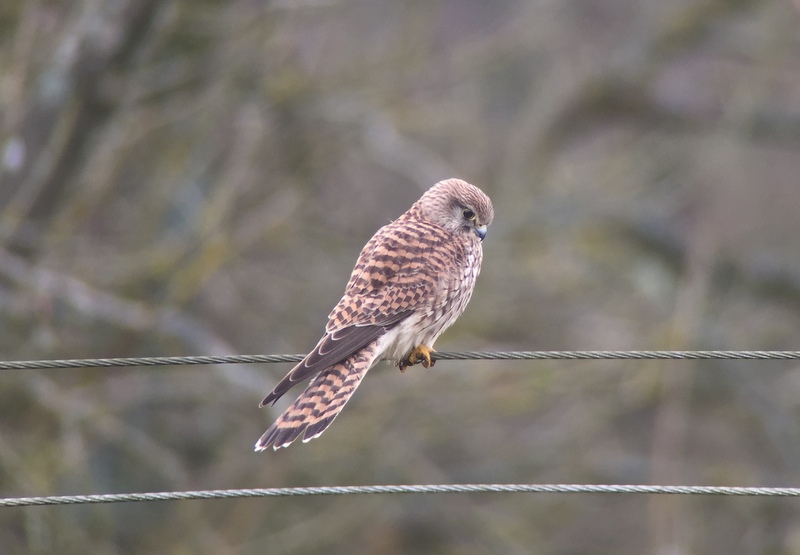A Brecks Tour today. Unfortunately, the weather forecast had deteriorated through the latter part of the week and the Met Office predictions took another turn for the worse late yesterday evening. There were warnings for ice overnight, rain, sleet and snow all day, plague, pestilence, the end of the world was nigh, etc. Some of the tour participants were understandably getting concerned. However, as we have seen particularly in recent weeks, the Met Office is frequently very wrong.
A closer look at the fine details revealed a lot of uncertainty in the forecast concerning the timing and pace of progression of the weather front heading our way. The forecast had it moving steadily east and then stopping over East Anglia, which always looked rather unlikely – but who are we to argue with a multi-million pound forecasting supercomputer! With our reassurances that it was worth going out anyway, as we can see birds in any weather, and a chink of improvement in the forecast again overnight, we met up in the morning at Lynford arboretum.
It was damp and spitting with rain on arrival (although no sign of the overnight ice we were promised). As we walked down the path into the arboretum, we could hear a Nuthatch piping from the trees. A Goldcrest was singing and a pair of Siskins was zooming around the treetops. Both Song Thrush and Mistle Thrush were singing too, great to hear both.
We made our way to the gate to have a look at the feeders. There was still no sign that they have been refilled since our last visit, but there was quite a lot of seed spread on the ground today. Lots of birds were taking advantage of it, particularly the tits. A steady stream of Coal Tits flew down in front of us. A Marsh Tit kept darting in further back, grabbing a seed before making a quick getaway for the safety of the trees. It was nice to see the two species together and look at the key differences between them. A Nuthatch also made frequent forays down to the seed and nuts.
 Nuthatch – a recent photo taken on the feeders
Nuthatch – a recent photo taken on the feeders
There were a few Chaffinches on the ground too, but no sign of any Hawfinches here again. They have not been seen under the trees here with any frequency this year – perhaps they are finding more food elsewhere or they have been put off by increased netting and ringing activity here. We decided to have a walk round the rest of the arboretum to see if we could find any of them there. A Treecreeper worked its way up one of the trees right in front before flying on ahead of us. We watched it scaling a couple of trees, before flying back down to the base of the next one along.
Then it started to rain. We made our way quickly back to the entrance and found a shelter to stand under, hoping that it would pass. While we stood there, we talked a little about the history of the Breckland and Thetford Forest, and the origins of Lynford Arboretum. It was at this point that the two of the participants who had been concerned by the weather forecast last night decided that it wasn’t for them – an understandable decision, under the circumstances. The rest of the group decided to carry on and try to make the best of it.
It wasn’t long before the rain seemed to ease, so we had another go at walking round the arboretum, but almost immediately it started raining harder again. We decided that a change of plan was in order. We made our way quickly back to the car and headed over to Lakenheath Fen. We were only half way there when we drove out from under the darker clouds and the rain stopped. Having warmed up and dried out in the car, we thought we should make the most of the improvement to walk straight out to the Washland viewpoint to see what we could see.
The river level was very high and had flooded over onto the washes either side. Lots of ducks had spilled out across the river and took off as we walked up onto the bank – Wigeon, Gadwall, Teal, Mallard, Shoveler and Tufted Duck. We had a look at them through the scope as they landed over on Hockwold Washes, the drakes looking very smart at this time of the year. A pair of Great Crested Grebes resplendent in summer plumage were sailing along the river.
Three or four pipits also flew up from the flooded vegetation in front of us calling and when they landed we could see they were Water Pipits. Unfortunately, they just wouldn’t stay still long enough for everyone to get a look at them through the scope, and kept scuttling out of view into the edge of the wet reeds.
There are a couple of Great White Egrets around the reserve at the moment, but they are not always along the river. The first egret we saw was much smaller – hunched up in on the bank on the edge of the river channel, a Little Egret. However, when we turned to look back along the river towards the road, a much larger white bird flew up briefly. When it landed again, we got it in the scope and could see its long, dagger-like yellow bill – one of the Great White Egrets. A stroke of luck to find it here today.
We started to make our way along the bank for a closer view, but before we had gone very far the Great White Egret took off again. This time it flew right across in front of us, over Hockwold Washes and landed behind the reeds on the other side. We had great flight views as it passed us by.
 Great White Egret – along the river from the Washland Viewpoint
Great White Egret – along the river from the Washland Viewpoint
Looking back from where it had come, we could see why it had flown. A narrowboat was making its way along the river towards us, flushing everything as it went. The Great White Egret flew again, away over towards the reserve this time. The Water Pipits all scattered and the remaining ducks fled over to the back of the Washes too. The bonus was four Snipe which it flushed too as it came past.
With most of the birds having flown off, we decided to make our way back to the visitor centre for the hot drinks which we had promised ourselves on the drive over. While we were enjoying those, we spent some time watching the feeders outside the windows. There were lots of Reed Buntings as usual and we had a closer look at the differences between males and females.
 Reed Bunting – there were lots around the feeders
Reed Bunting – there were lots around the feeders
There were plenty of Goldfinches, Chaffinches and a Greenfinch or two as well. A pair of Siskin dropped in to feed on the bird table, allowing us great close-up views from the warmth of the visitor centre through the window. An interesting looking tit darted in quickly – probably just a Marsh Tit, though appearing rather richly coloured and thick-necked – but unfortunately we just got a glimpse of it and it didn’t return while we were there.
 Siskins & Goldfinch – on the bird table from the visitor centre
Siskins & Goldfinch – on the bird table from the visitor centre
With the weather still dry, and having warmed up nicely now, we decided to head back out to the forest and resume our plan for the day. There has been a Great Grey Shrike around the area for the winter, but it is very mobile and can be hard to find. We decided to chance our luck at one of its favoured sites on our way back. We walked down along the path to the edge of the clearing and found a spot from where we could scan the bushes. Half obscured from where we were standing, through the vegetation, we could see a grey shape on the top of a small hawthorn. We repositioned ourselves so we could get a clear view across and there was the Great Grey Shrike.
We had a great look at the Great Grey Shrike through the scope, looking strikingly pale from a distance, with silvery grey upperparts and bright white below, but with contrasting black wings and a black bandit mask. It flew across between bushes a couple of times, generally landing on the top or another good vantage point from which it could scan the ground below for prey – often beetles here, but also small mammals or even small birds if they are available.
 Great Grey Shrike – back in its favoured clearing today
Great Grey Shrike – back in its favoured clearing today
While we were standing there, we could hear a Woodlark singing. It flew towards us over the trees, fluttering its broad wings and came straight over our heads. We could see the very short tail. The Woodlark’s song has a sad and mournful quality to it, though every bit as beautiful as the more joyful Skylark which started singing a few moments later. The Woodlark flew back away over the trees. So, having enjoyed good views of the Great Grey Shrike, we decided to try another site to find a Woodlark on the ground.
As we walked out along the forest track, all seemed quiet at first, but then a Woodlark starting singing. It flew across the path in front of us and then appeared to land further along. As we walked further, it suddenly flew up again and over our heads singing, before landing on the short grass just behind us. We got it in the scope and had a goo look at it, noting the pale supercilia joining in a shallow ‘v’ on the back of the neck, before a walker coming towards us along the path flushed it again. Having enjoyed the Woodlark’s songflight earlier, it was great to see one on the ground too.
 Woodlark – a recent photo taken in the forest
Woodlark – a recent photo taken in the forest
After a break for a late lunch, we decided to return to Lynford Arboretum to have a good go at catching up with a Hawfinch. We didn’t linger long by the feeders this time, but headed straight down towards the paddocks. Someone had sprinkled lots of food – crumbs, nuts and seeds – on the posts and pillars of the bridge and lots of birds were coming in to feed, including several Siskins and several Marsh Tits. Again, we didn’t hang around too long, just in case.
It was a good think we didn’t. We had just arrived at the paddocks and started to scan the trees in the middle for any signs of activity when we noticed a shape in the very top of one of the pine trees behind. We got it in the scope and confirmed our suspicions – a Hawfinch. We all got a good look at it before it dropped down out of view.
 Hawfinch – here’s one from the other day in the same place
Hawfinch – here’s one from the other day in the same place
As it was still relatively early, we thought a Hawfinch might drop back down into the paddocks, so we waited a while there. There was lots more activity around the trees in front of us. A couple of Jays perched up enjoying the afternoon sun – for there were even some breaks in the cloud this afternoon, despite the Met Office’s direst predictions.
 Jay – enjoying the afternoon sun!
Jay – enjoying the afternoon sun!
There were also lots of thrushes on offer. A Song Thrush was singing from the top of one of the ash trees, so we had a good look at that in the scope. Then a Mistle Thrush appeared in the top of one of the other trees for a convenient comparison. A sharp-eyed member of the group spotted a little group of thrushes over the other side of the paddocks and in with the Blackbirds and Song Thrushes a single Redwing perched preening in the sunshine.
 Mistle Thrush – in the top of one of the trees in the paddocks
Mistle Thrush – in the top of one of the trees in the paddocks
There is often a Kestrel around the paddocks too, and today she spent the time hunting from the telegraph wires which cross the paddocks, dropping down periodically to the grass below.
 Kestrel – hunting from the wires across the paddocks
Kestrel – hunting from the wires across the paddocks
There was still no more sign of any more Hawfinches, so we had a walk round to check the tops of the trees on the sunny side, which was more sheltered from the wind. Nothing there, so we decided to head back. We scanned the tops of the trees as we walked, but it was only when we got almost back to the bridge that we noticed a large bird in the tops of the pines. A quick look through the scope confirmed it was another Hawfinch before it too dropped down out of view.
We made a quick tour of the arboretum, getting a good look at a singing Goldcrest in the process. We then finished off with a quick visit to the old gravel pits the other side of the car park. No sign of the Goosander there today, but we did see a little group of five Goldeneye, two pairs of Great Crested Grebe and a single Oystercatcher on the tern platform. A Kingfisher flashed across the water, unfortunately too quickly for most of the group to get onto it. Then it was time to call it a day.
Despite the early inclement weather and the best efforts of the Met Office to put us off, we had actually enjoyed a very successful day’s birding – with good views of Great Grey Shrike, Hawfinch, Woodlark and Great White Egret, to name but a few highlights, as well as an excellent supporting cast of woodland and wetland birds.
It just goes to show two things:
- It is always worth coming out birding, whatever the weather forecast; and
- Never trust the Met Office’s best predictions!
















